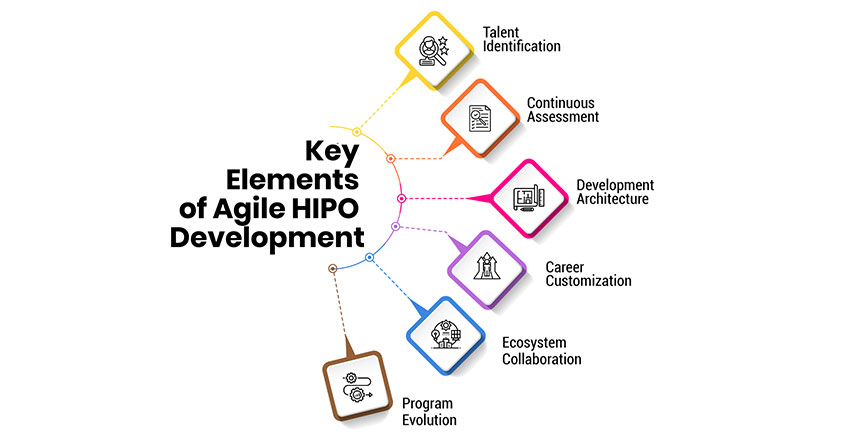
In an exponentially changing world, organizational adaptivity is vital for business resilience and growth. But fostering such agility ultimately comes down to empowering the right people - your high-potential future leaders. This article explores how human resources can systematically nurture employee potential via “HIPO” development strategies built on agile principles.
By combining data-driven talent analytics with iterative skill-building frameworks, you create an engine for continuous workforce optimization. The result is an agile “talent factory” producing adaptable leaders and accelerating competitive advantage. So, let’s examine how.
In Deloitte’s 2019 Global Human Capital Trends survey, 80% of executives rated building organizational agility as a top-priority challenge. They understand how mounting disruption demands resilient and adaptive enterprises where innovation happens quickly.
But the type of agility needed today goes beyond short-term flexibility. Leaders must foster an always-on, organization-wide capability to rapidly process change and pivot employee strategies without losing momentum. Think of it as organizational metabolism metabolizing market fluidity.
This starts with HR strategies to nurture high potential employee groups who can steer such metabolism. Let’s focus specifically on high-potential middle managers and early seniors with leadership promise – the “HIPOs”.
Surveys indicate only 12% of companies feel fully confident in their leadership pipelines to drive future growth. Meanwhile, external hiring gets tougher with acute talent scarcity.
So, a key source of strategic talent must be internal – promising managers groomed via specialized HIPO programs interpolated with agile models. Doing this at scale builds a talent engine powering adaptable leadership.
Before exploring agile HIPO development, let’s ground the key concepts underpinning modern agile frameworks.
The ethos of releasing work in short, repeated cycles with continuous user feedback fuels the iterative delivery mindset. This allows for real-time refinements, adaptation, and evolution of the product/solution rather than waiting long periods for the course to correct.
The exponentially faster feedback accrued through regular delivery sprints is what enabled disruptive digital startups to rapidly outmaneuver incumbents. When applied to talent development, it translates to shorter modular learning bursts aligned to need rather than marathon training programs. This accelerative cycle allows skills to compound.
Rigid long-term roadmaps freeze development trajectories despite fluid market realities. An adaptive planning mindset favors iterative planning cycles where directions pivot dynamically based on emerging needs and priorities.
When applied to workforce development, this manifests as continuous fine-tuning of capability-building priorities across learner groups based on frequent strategy sync-ups. Rather than fixed assumptions driving yearly L&D plans, adaptivity allows responding to changing competence needs.
Agile is built on autonomous, cross-functional teams owning entire product or solution cycles rather than components or phases. This instills greater context, accountability, and commitment. Such teams are guided, not instructed, via platforms that enhance transparency, coordination, and alignment vs top-down control.
In talent development terms, this points to empowered learner groups directing their own competency-building journeys across interdisciplinary domains beyond narrow skill silos. Mentorship partnerships provide support tools for alignment and progression vs prescriptive processes.
Traditional requirement gathering for solutions often depends on secondary research or internal assumptions of user needs. Agile user-centricity demands direct, contextual target user experiences via ethnographic immersion to drive innovation from the outside in.
Applied to workforce training, this entails learning interventions shaped bottom-up directly from employees’ specified capability needs versus top-down analytic assumptions or yearly surveys. Regular touchpoints capture granular, individual desires.
Linear skill improvement assumes talent growth through incremental steps bounded by limited beliefs. A growth mindset believes abilities can be developed exponentially over time by adopting new learning approaches without self-imposed limits.
For agile teams, this manifests as a culture of continuously upgrading capabilities ahead of the curve rather than waiting for disruption. In talent strategies, this points to self-directed, infinite learning pathways shaped by employees to stay ahead of the curve.
The principles ultimately provide a paradigm to accelerate the quality, efficacy, and speed of talent development cycles for organizational readiness. Underpinning popular agile frameworks, these mindsets hold immense potential.
Traditional high-potential programs rely on dated paradigms, such as locked annual cycles assessing static traits, prescribed development plans, etc. However, disruptive times demand fundamentally more dynamic HIPO processes.
In agile talent management, integrating concepts like:
Undergirding such interventions is continuous A/B testing of engagement triggers against talent metrics. This fail-fast, data-backed approach nurtures relevance amid fluidity.
Additionally, divisional rotations and external immersion programs create contextual learning beyond narrow functional domains. Think of such initiatives as talent R&D, an investment into leadership innovation.
Through this agile learning loop, HR accelerates capability development cycles across the HIPO talent factory. Rapid skill application and assimilation unlock exponential productivity and readiness for adaptable leaders.
While detailed program constructs must align with specific organizational contexts, high-level focus areas are:

Breaking dated paradigms of rapid, exclusive selection, modern HIPO development is more inclusive, with porous talent flows across programs at each maturity stage. Pathways to enter and graduate across layers create mobility.
Regular performance data via automation and user feedback provides a dynamic evaluation of competence, aspiration, and alignment to roles. This increases accuracy over dated annual reviews.
Employing agile constructs like sprint cycles, sandboxed projects, and real-time feedback centered around learning outcomes accelerates competency development through repetitions.
Leveraging internal gig platforms and mentor partnerships, employees can access AI-recommended assignments matching individual growth needs and business priorities. This unlocks autonomy and purpose.
Engaging selective external partners, education platforms, and talent communities provides outside-in perspectives and cross-industry connections to amplify leadership bandwidth.
Continuous measurement of outcome metrics like participant yield, capability enhancement, and business impact allows rapid iteration of engagement models, pivots, and optimization for relevance amid market fluidity.
The future will demand enterprise-wide capabilities to continually anticipate, adapt, and accelerate at scale. This necessitates leadership to be able to steer such an organizational metabolism.
By taking an exponential view of talent development and embedding agile constructs targeting high-potentials, HR catalyzes an adaptive leadership engine through the following outputs:
Collectively, such high-potential development strategies constitute an agile talent factory producing adaptable leaders and exponential growth runways critical for enterprise resilience.
Rather than periodic programs creating episodic value, agile HIPO strategies powered by automation and analytics generate continuous leadership bandwidth and organizational fluidity demanded today.
As escalating disruption redefines markets, static business, and HR models expire. Sustaining growth requires building dynamic capabilities through empowered people and rapid transformation cycles.
Agile development principles and exponential technologies aptly serve this need when applied to managing high-potential future leaders. By continually aligning potential to priorities, you unleash an adaptive organizational metabolism steeped in learning and innovation.
The outputs are versatile leaders and self-upgrading teams prepared to traverse uncharted landscapes ahead. That’s the essence of an agile talent factory model - feasible today via the powerful intersection of people capability with AI capacity. The journey begins with reimagining HIPO strategies for new realities.